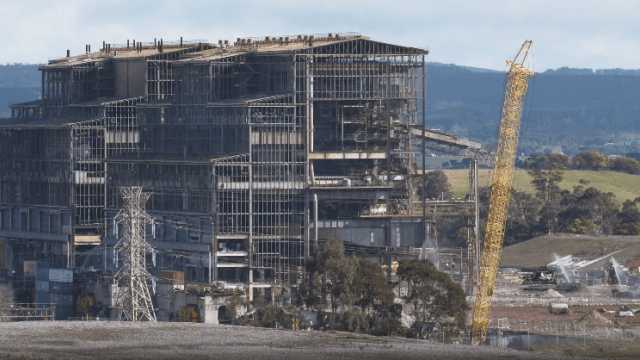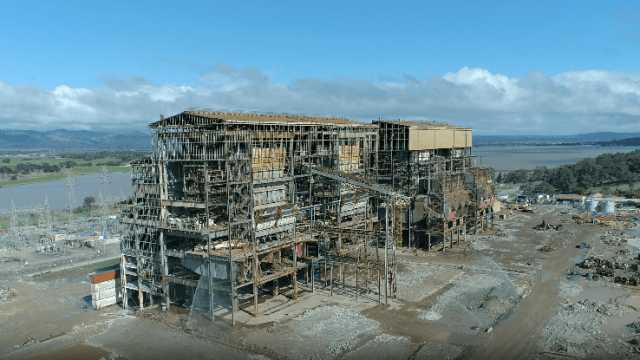A closer look at the former Hazelwood Power Station
Demolition of the former Hazelwood Power Station and mine infrastructure was a major component of the rehabilitation works to enable new uses for the Hazelwood site.
ENGIE Hazelwood appointed Delta Group, a Melbourne-based nationally recognised company, as the Principal contractor to undertake these works.
Delta Group and ENGIE Hazelwood worked with a further team of local and international technical and demolition experts, in conjunction with regulators and agencies, to develop and deliver a safe and effective demolition approach for the entire site.
The demolition program included the demolition of eight chimneys in May 2020, and the four Boiler Houses and all large mining equipment in the Hazelwood mine.
Chimney Demolition
The eight iconic 137m tall chimneys at Hazelwood Power Station were successfully demolished on 25 May 2020.
For ENGIE and the Hazelwood Rehabilitation Project team, this represented the culmination of an enormous amount of pre work and planning, and was an important milestone toward delivering a safe, stable and non-polluting site back to the community.
ENGIE Hazelwood management congratulated the entire team, including the numerous local emergency services support agencies, who successfully achieved this major milestone activity.
Boiler House Demolition
Boiler House 4, 15 December 2020
The remaining structure of Boiler House 4, Unit 7, at the former Hazelwood Power Station was successfully felled on 15 December 2020 using explosive demolition methods.
The structure and dust suppression measures behaved as modelled, ensuring the safety of all site personnel as well as the local community.
Extensive fire suppression systems were put in place in the lead up to the works as a precaution against any fire issues and worked well.
Boiler House 3, 28 April 2021
Boiler House 3 at the former Hazelwood Power Station was successfully felled on Wednesday 28 April 2021 using explosive demolition methods.
Boiler House 2, 17 August 2021
Boiler House 2 at the former Hazelwood Power Station was successfully felled on Tuesday 17 August 2021.
The demolition works had been delayed from the original June 2021 date after the impact of storms and flooding in the region during that month.
Boiler House 1, 19 October 2021
Boiler House 1 at the former Hazelwood Power Station was successfully felled on Tuesday 19 October 2021 using explosive controlled collapse demolition methods.
The structure, along with extensive vibration and dust suppression measures, behaved as modelled to ensure the safety of all site personnel, the local community and nearby assets.
The demolition took place at 11.26am, within the nominated window for the fell.
Large Mining Equipment (dredger) demolition, May 2021
Hazelwood Dredger 9 Fell Success
The final dredger demolition works were carried on Thursday 6 May 2021. The Dredger was demolished by controlled explosive collapse on schedule at 11am, safely bringing to ground the piece of large mining equipment to enable processing and recycling.
The event followed months of demolition planning by the demolition contractor Delta Group, the ENGIE Hazelwood team and international subject matter experts. The dredger fell as planned onto a sand and clay dampening pad, which was set up to reduce any potential vibration impact. All of the blast cutting charges were fully expended with no misfires and, with a cool and misty day, no issues are expected with hot spots. Monitoring of the site will continue for 24 hours as a safety precaution.
Dredger 9, built in 1964, is the last of the dredgers demolished at Hazelwood. Dredgers 11 and 10 were also demolished by controlled explosive collapse in 2020, with a further two dredgers, 24 and 25, mechanically dismantled. An ENGIE spokesperson acknowledged that the final dredger demolition signals the end of an era.
Many people have been associated with the former Hazelwood Power Station and Mine and the bucket wheel excavators, which were symbolic of the industry
The photos show the moment of detonation and the result, Dredger 9 safely on the ground.
Hazelwood sign removal – 2019
The historic ‘Hazelwood’ sign at the former Hazelwood Power Station has been removed – but it won’t be forgotten.
The highly visible red letters were carefully removed on 9 February 2021 by demolition contractors Delta Group and will now go into storage until plans for its future are finalised.
The sign, set up in 1966, is about 25 metres long and each letter stands 1.82 metres (six feet) high. The letters are of varying widths with the ‘W’ the widest at some two and a half metres. Finished in red vitreous enamel, each letter was fitted with four rows of red neon tubing which provided the distinctive red sign.










